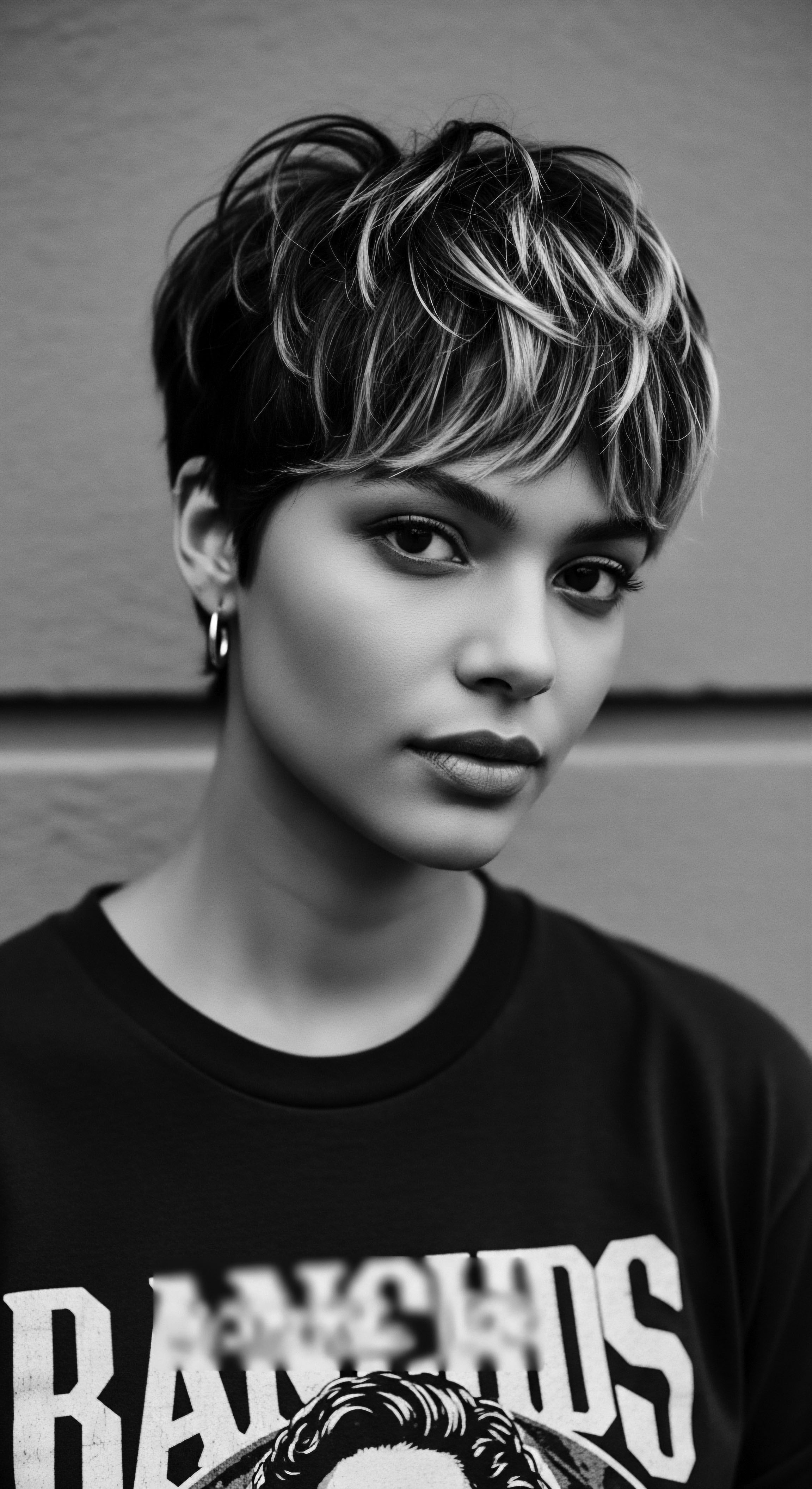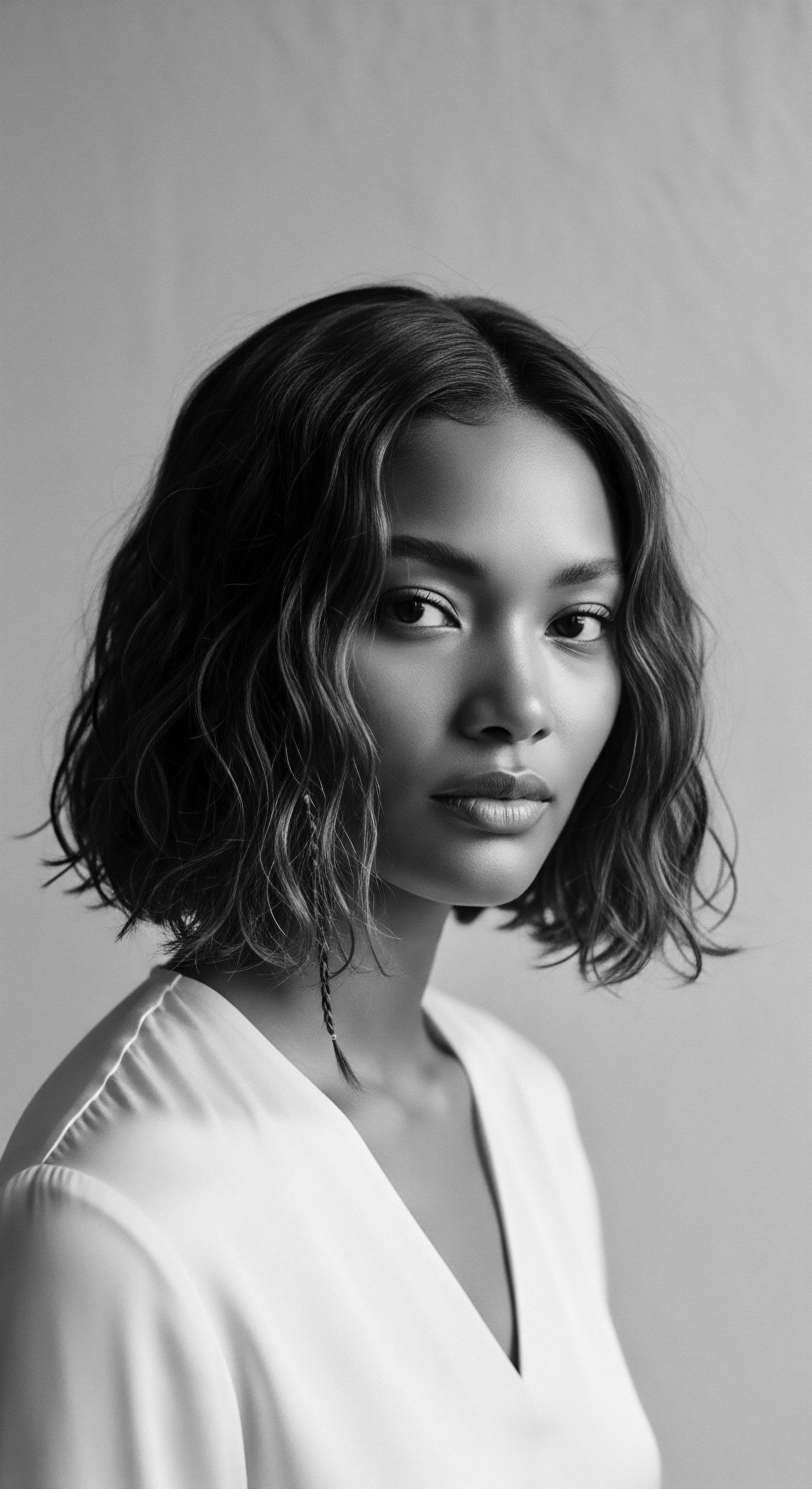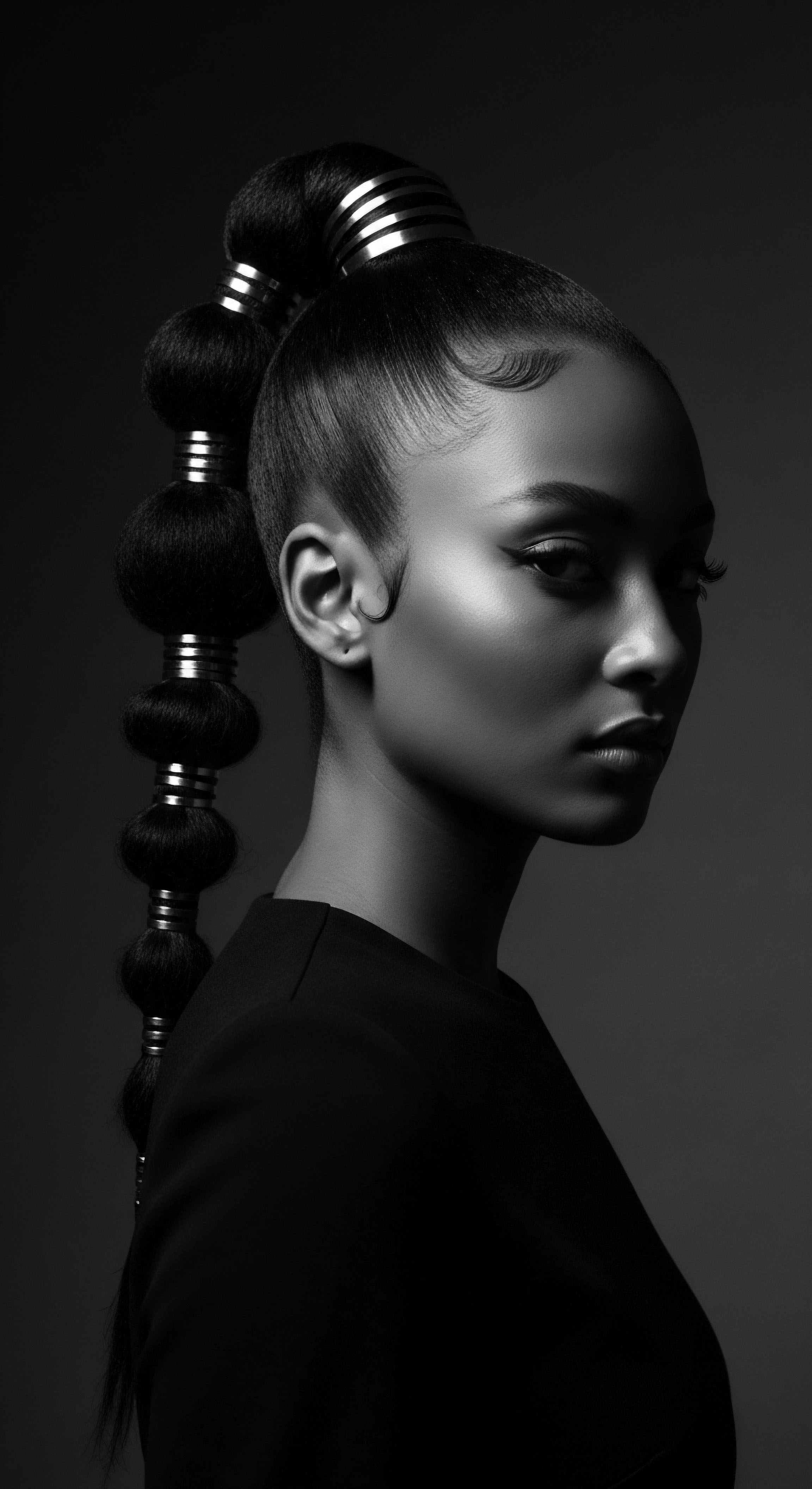
Roots
To journey into the scientific basis of oils tending to the moisture within textured hair is to begin not in the sterile quiet of a laboratory, but amidst the rustle of ancient leaves and the rhythm of communal life. It is an invitation to listen to the whispers carried on the wind, stories from hands that have, for countless generations, recognized the profound wisdom inherent in nature’s bounty. For those with hair that coils and bends, that defies the straight line, the relationship with moisture is not merely a cosmetic concern; it is a fundamental aspect of its very being, a memory encoded in each strand, echoing a long heritage of adaptation and resilience. Our exploration of oils and their scientific support in nurturing textured hair is, at its heart, a return to the source, a recognition that the understanding we seek now was often observed and applied with profound intuition by ancestors.

Hair’s Architecture and Ancestral Understanding
The distinct geometry of textured hair, often characterized by its elliptical cross-section and numerous bends and twists along the shaft, renders it inherently more prone to moisture loss. Unlike straight hair, which allows the scalp’s natural lipids to descend with relative ease along a smoother path, the helical patterns of curly and coily strands present a formidable obstacle. This architectural reality creates numerous points where the hair cuticle, the outermost protective layer, can lift. When the cuticle lifts, the inner cortex, home to the hair’s moisture and structural proteins, becomes exposed, leading to evaporation and a feeling of dryness.
The challenges of maintaining hair’s hydration in varying climates, particularly arid ones, were keenly felt by ancestral communities across Africa and the diaspora. Their practices were, in effect, early forms of scientific inquiry, their observations leading to solutions passed down through time.
Consider the microscopic layers that comprise a single hair strand. The outermost Cuticle is a series of overlapping scales, like shingles on a roof. A healthy cuticle lies flat, presenting a smooth surface that reflects light and seals in hydration. Beneath this lies the Cortex, which comprises the majority of the hair’s mass, holding its strength and elasticity, along with the bound water that gives hair its pliability.
The innermost core, the Medulla, is not always present in every hair type but contributes to the hair’s bulk. For textured hair, the cuticle’s propensity to lift is a significant factor in moisture retention. This architectural predisposition to dryness meant that traditional societies, particularly in regions with harsh environmental conditions, developed a deep functional understanding of how to seal and protect hair.
The unique helical form of textured hair predisposes it to moisture loss, a challenge addressed by ancestral wisdom long before modern science.

How does Hair’s Natural Architecture Relate to Moisture Needs?
The very shape of textured hair, its spirals and curves, means that the natural oils produced by the scalp, known as sebum, struggle to travel the full length of the hair shaft. This leaves the mid-lengths and ends particularly vulnerable to dehydration. Each bend in a coil presents a structural point where moisture can escape and where the cuticle can become compromised through daily manipulation or environmental exposure. This understanding, though not articulated in biochemical terms, was implicit in the widespread ancestral practice of applying external lipids to hair.

What Ancestral Observations Shaped Early Hair Care?
Ancestors, without the benefit of electron microscopes, possessed an intimate knowledge of their hair’s behavior under different conditions. They observed that certain plant extracts, when applied, created a discernible sheen, made hair softer to the touch, and reduced breakage during styling. They would have noted how exposure to sun and wind intensified dryness, leading them to seek out ingredients that offered protection. This practical application of botanical resources became integral to daily life and rites.
The use of natural ingredients like shea butter in West Africa and coconut oil in various tropical regions of the diaspora exemplifies this generational wisdom. These substances were not chosen at random; their efficacy was proven through consistent, lived experience over centuries, forming a practical science of hair care rooted in observed results.
| Textured Hair Trait Helical Shape and Sebum Distribution |
| Ancestral Observation and Response Scalp oils do not easily reach hair ends; led to external oil application. |
| Modern Scientific Link Sebum cannot traverse the coil's path, necessitating exogenous lipid supply. |
| Textured Hair Trait Cuticle Lifting Tendency |
| Ancestral Observation and Response Hair felt rough, looked dull, broke easily; prompted use of smoothing agents. |
| Modern Scientific Link Opened cuticles allow moisture escape; oils provide a sealing barrier. |
| Textured Hair Trait Vulnerability to Environmental Stress |
| Ancestral Observation and Response Sun, wind caused dryness; drove search for protective balms. |
| Modern Scientific Link Oils form a physical shield against UV radiation and desiccation. |
| Textured Hair Trait Ancestral practices, born from acute observation, laid the groundwork for our current understanding of hair's needs. |

Ritual
The application of oils to textured hair, beyond its molecular underpinnings, has always been a profound act, a living ritual passed from elder to youth. It is a tangible connection to ancestral hands and the wisdom they carried. This practice, steeped in cultural significance across African and diasporic communities, was never merely about superficial aesthetics; it was about preserving hair’s vitality, protecting it from the elements, and fostering a sense of communal identity. The scientific mechanisms we now understand offer a deeper appreciation for the intuitive effectiveness of these longstanding traditions.

The Sacred Act of Oiling
The ritual of oiling hair stretches back through generations, embodying care, connection, and a deep respect for the physical self as a vessel of heritage. In many West African societies, the preparation and application of shea butter, for instance, involved community effort, often by women, transforming the nuts of the shea tree into a golden, nourishing balm. This was not a quick task, but a thoughtful process, reflecting the value placed on the substance and its eventual use on skin and hair.
Similarly, the use of castor oil, brought from Africa to the Caribbean during the transatlantic passage, quickly became a staple, its thick consistency and perceived benefits making it a cornerstone of hair care for survival and beauty in a new land. These actions were not isolated; they were part of a larger continuum of self-care and communal bonding.
The scientific qualities of oils contribute directly to their ability to help textured hair hold onto moisture. Oils possess both emollient and occlusive properties. As an Emollient, an oil fills the microscopic gaps and irregularities on the hair’s cuticle surface, smoothing it down.
This action creates a more uniform surface, which both reduces friction between strands—a common cause of breakage in coiled hair—and allows light to reflect more evenly, giving hair a healthy appearance. This smoothing effect, observed centuries ago as increased shine and manageability, aligns with modern understanding of cuticle integrity.
The historical act of oiling hair, often a communal ritual, deeply connects to the scientific actions of emollients smoothing the cuticle.

What Qualities of Natural Oils Align with Ancestral Practices for Hair Health?
Secondly, and perhaps more critically for moisture retention, oils act as an Occlusive Barrier. Once applied, they form a protective film on the hair shaft, which slows down the rate at which water evaporates from the hair’s interior. This is particularly important for textured hair, which tends to be more porous and loses moisture quickly to its environment. In arid climates where many African communities resided, or during long sea voyages, creating such a barrier was a survival mechanism for hair health.
Ancestral knowledge recognized that certain oils, with their specific densities and textures, offered superior protection against desiccation. This intuitive understanding of occlusive properties allowed for the preservation of hair’s natural hydration, preventing the brittleness that can lead to breakage.
The distinction between oils that penetrate the hair shaft and those that primarily coat its surface also held ancestral significance, even if not articulated in molecular terms. Oils with smaller molecular structures, such as coconut oil, have been shown to have a greater ability to penetrate the hair’s cortex, potentially reducing protein loss and fortifying the strand from within. Larger molecular oils, like castor oil or shea butter, tend to remain more on the surface, providing excellent sealing and lubrication.
Traditional practitioners likely discerned these differences through observation of how different oils performed for varying hair conditions and environmental exposures. This led to specific applications or blends for different purposes – a lighter oil for daily nourishment, a heavier butter for deep conditioning or protective styling.

How do Varied Textures Affect Oil Application?
The diverse range of textured hair, from loose waves to tight coils, means hair responds uniquely to oil application. Tightly coiled hair, with its numerous twists, faces a greater challenge in retaining moisture because its natural oils struggle to travel down the shaft, and its cuticle layers are more exposed to the environment. This physical reality underscores the importance of externally applied oils. In ancestral contexts, the choice of oil and the frequency of application would have been tailored to the individual’s specific hair pattern and local climate.
For example, thicker, richer butters might be preferred for very coily hair in dry conditions, while lighter oils might suffice for wavier textures or in more humid environments. This personalization, guided by observation and tradition, mirrors contemporary scientific approaches that consider hair porosity and density when recommending products.

Relay
To truly grasp the scientific mechanics behind oils aiding textured hair in retaining moisture is to bridge the wisdom of ancestral practices with the insights of modern chemistry. This understanding does not diminish the heritage aspects; rather, it amplifies the ingenuity embedded in traditions that predate contemporary laboratories by centuries. The relay of knowledge, from elemental biology to communal application and back, reveals how deeply connected the scientific is to the cultural.

The Chemistry of Oil and Hair Fiber
Oils, at their core, are lipids, primarily composed of fatty acids. These fatty acids can be saturated, monounsaturated, or polyunsaturated. This chemical composition dictates an oil’s properties, including its viscosity, how it interacts with water, and its ability to penetrate the hair shaft. Hair itself contains natural lipids, particularly the 18-methyl eicosanoic acid (18-MEA) on the outermost cuticle, which contributes to its natural hydrophobicity, meaning its ability to repel water.
When this natural lipid layer is compromised by daily styling, environmental stressors, or chemical treatments, hair becomes more vulnerable to moisture loss. Oils step in to supplement or replace these lost lipids, effectively restoring a protective layer.
A significant aspect of oil efficacy lies in its Molecular Size and Structure. Smaller molecular weight oils, such as coconut oil, are renowned for their ability to penetrate deeper into the hair shaft, reaching the cortex. This penetration is not merely superficial; it helps to reduce the swelling and contraction of the hair fiber during wetting and drying cycles, a phenomenon known as hygral fatigue. Hygral fatigue weakens the hair over time, making it brittle and prone to breakage.
By mitigating this constant expansion and contraction, penetrating oils help preserve the hair’s structural integrity and elasticity. Coconut oil, specifically, has a straight linear chain structure that allows it to move past the cuticle layers and into the cortex, contributing to reduced protein loss.
Conversely, oils with larger molecules, like castor oil or shea butter, tend to form a more substantial film on the hair’s surface. This surface coating is highly effective in providing an occlusive barrier, preventing moisture from escaping the hair and shielding it from external humidity or dryness. While they may not penetrate as deeply, their ability to seal the hair provides an immediate benefit in moisture retention and imparts a visible sheen and smoothness by flattening the cuticle scales. The distinct properties of these oils mean that a holistic hair care approach, often seen in ancestral practices, might combine them ❉ a penetrating oil for internal fortification and a sealing oil for external protection.

Do Ancestral Oil Applications Align with Modern Hair Science?
The alignment between ancestral hair care practices and contemporary scientific understanding is striking. For generations, communities utilized oils and butters not just as beauty aids but as functional agents to preserve the integrity of textured hair in challenging environments. Consider the Basara Tribe of Chad, whose use of a traditional hair mixture containing herbs and animal fat, often referred to as Chebe, has been associated with significant length retention.
While scientific studies on Chebe specifically are less common in mainstream literature, the foundational principle behind its efficacy—creating a protective barrier to reduce breakage and moisture loss—is consistent with modern scientific understanding of oil’s occlusive benefits. This tradition, passed down through women, directly addresses the inherent fragility of textured hair by physically fortifying the strands and reducing the opportunity for moisture evaporation and mechanical damage.
A study exploring the penetration of vegetable oils into textured hair, using advanced techniques like Matrix-Assisted Laser Desorption Ionization Time-of-Flight Mass Spectroscopy (MALDI-TOF MS), found that oils like argan, avocado, and coconut oil were present in the hair cortex. The study noted differences in how homogeneously oils diffused in textured hair compared to straight hair due to the former’s unique cortical structure. This suggests that while oils do penetrate, the irregular distribution within textured hair might influence their mechanical effects differently than in straight hair. Despite this, the core scientific principle of oil ingress and its lubricating effect on the outermost cuticle and cortex in virgin hair remains a validated mechanism for increasing resistance to fatigue and improving manageability.
The scientific properties of oils, from molecular size to fatty acid composition, explain their role in hair’s resilience.

How do Environmental Factors and Oil Use Interconnect?
The interplay between environmental conditions and the need for oil in textured hair care has always been significant. In environments with low humidity, hair loses moisture to the air more rapidly. Here, the occlusive properties of oils become paramount, forming a seal that slows this desiccation. Conversely, in highly humid conditions, textured hair is prone to excessive water absorption, leading to hygral fatigue—the repeated swelling and shrinking of the hair shaft that weakens it.
Oils, particularly those that penetrate the hair, can help mitigate this by filling microscopic cavities and limiting water uptake, thereby stabilizing the hair’s structure. This environmental adaptation in oil use was likely understood through observation by those who maintained textured hair in various climates across the diaspora. For instance, communities in regions with intense sun exposure, such as parts of Southern Africa, used specific oils like Mongongo oil, which has properties to form a protective film under UV light, shielding the hair from sun-induced damage. This illustrates a sophisticated ancestral understanding of environmental protection.

Reflection
Our journey through the scientific basis of oils assisting textured hair in moisture retention inevitably leads us back to where we began ❉ the profound connection between heritage, self, and the living archive that is textured hair. The meticulous layering of ancestral observations with the precise language of chemistry does not diminish the sacredness of a strand; rather, it deepens our reverence for the intuitive wisdom that guided generations. Each coil and bend holds stories of resilience, of adaptation, and of the enduring spirit that transformed simple botanical extracts into acts of profound care and cultural preservation.
The enduring practice of oiling, from the communal shea butter preparations in West African villages to the Jamaican castor oil traditions carried across oceans, is a testament to an ancestral understanding that transcended formal scientific nomenclature. They witnessed the calming of frizz, the softening of texture, the visible sheen, and the reduction of breakage, knowing these were signs of vitality. Modern science, with its ability to measure molecular penetration, cuticle flattening, and reduction of hygral fatigue, simply provides a granular explanation for what was already known through lived experience and passed down through the gentle, knowing touch of hands that cared.
Textured hair, in all its varied expressions, remains a profound symbol of identity and continuity. The oils we choose, whether rooted in ancient traditions or modern formulations, are not simply products; they are extensions of a long lineage of care, a continuous conversation between past and present. When we nourish our coils and curls with oils, we are not just tending to physical strands; we are honoring the wisdom of those who came before, ensuring that the legacy of strength, beauty, and self-possession continues to flourish, a living testament to the soul of a strand.

References
- Agero, R. & Abe, M. (2009). The effect of coconut oil on damaged hair. Journal of Cosmetic Science, 54(5), 459-472.
- Draelos, Z. D. (2010). Hair cosmetics. Clinics in Dermatology, 28(4), 450-453.
- Gavazzoni Dias, M. F. R. (2015). Hair cosmetics ❉ An overview. International Journal of Trichology, 7(1), 2-15.
- Keis, K. et al. (2007). Effect of oil films on moisture vapor sorption of human hair. Journal of Cosmetic Science, 58(4), 415-424.
- Lourenço, C. Gasparin, R. M. & Mantovani, C. (2024). Penetration of Vegetable Oils into Textured Hair Fibers ❉ Integrating Molecular Matrix Assisted Laser Desorption Ioni-Zation Time-of-Flight Mass Spectroscopy (MALDI TOF/TOF MS) Analysis with Mechanical Measurements. MDPI.
- Mohanasundari, S. & Kumar, A. (2022). A Method to Measure Oil Penetration into Hair and Correlation to Tensile Strength. International Journal of Trichology, 14(4), 128-134.
- Rele, J. & Mohile, R. (2003). Effect of mineral oil, sunflower oil, and coconut oil on prevention of hair damage. Journal of Cosmetic Science, 54(2), 175-192.
- Tharps, L. (2001). Hair Story ❉ Untangling the Roots of Black Hair in America. St. Martin’s Press.
- Verma, S. & Singh, S. (2020). Hair Oils ❉ Indigenous Knowledge Revisited. International Journal of Trichology, 12(3), 89-94.
